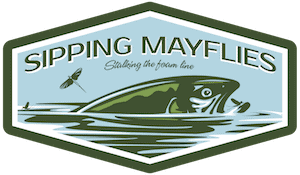Fly Fishing For Jack Crevalle
July 24th, 2023
Jack crevalle are my favorite fly fishing quarry because they’re aggressive feeders and are some of the hardest fighting fish in saltwater. Casting to a school of them is nothing short of electric!
After having caught many of them on beaches and in skiff boats, I’ll explain to you the tactics and techniques I use to hook into these pelagic fish including where to find them, how to fight them, and the best flies to use.
I’ll even share a picture of an interesting experience I had when landing a monster jack. And with that, let’s get started.
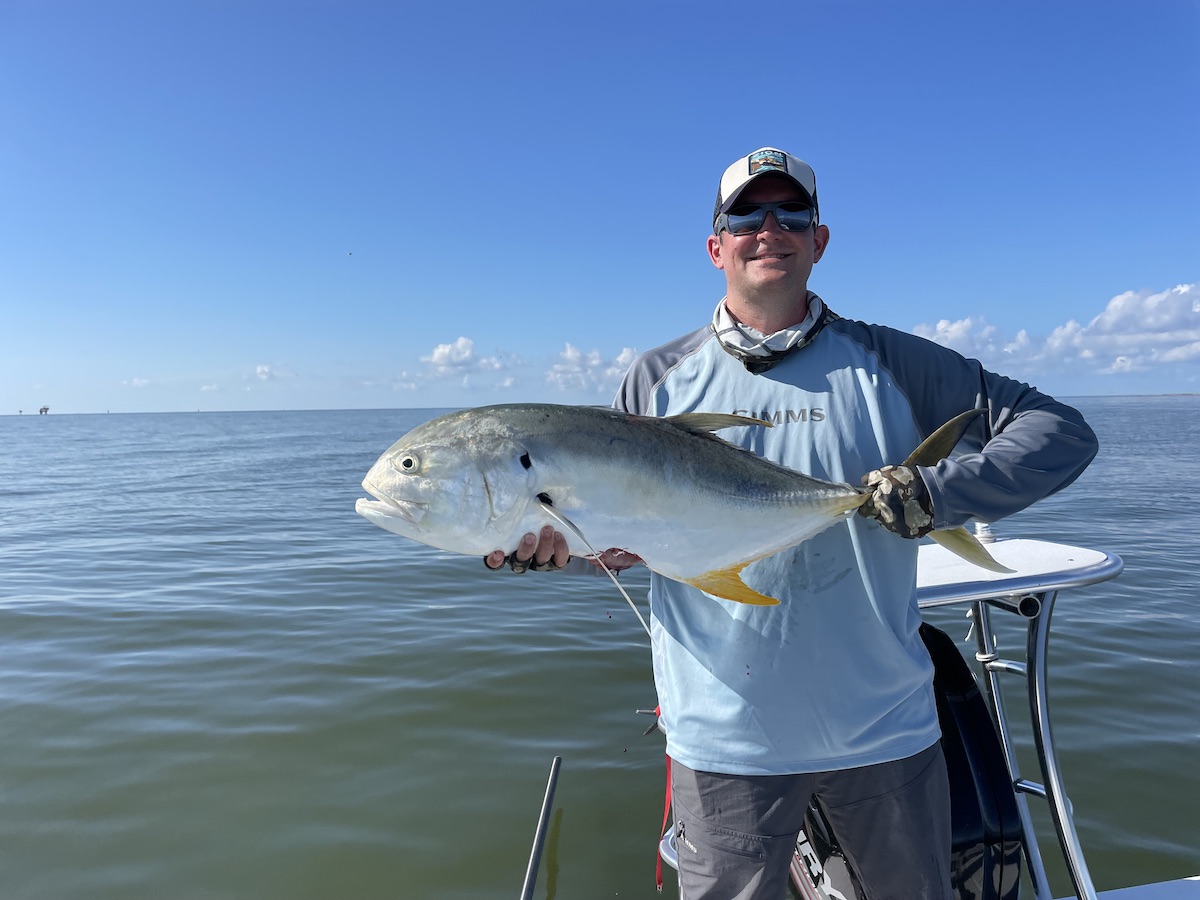
Here’s a large jack crevalle I caught while fly fishing in the Gulf of Mexico in September. I was casting a hopper pattern in the midst of a feeding frenzy.
Jack Crevalle Size and Weight
The scientific name of a jack crevalle is Caranx hippos. In latin, caranx means “Caribbean fish” while hippos means “horse.” The name seems fitting for this species. They are member of the Carangidae (jack) family.
Some anglers call these fish the “poor man’s permit,” while other names include black cavalla, couvalli jack, horse-eye jack, green jack, and common jack.
Most adults reach a total length of around 24-inches, but 40+ inchers aren’t unheard of, especially off the western coast of Africa. In fact, the world record jack crevalle was caught off the coast of Angola and weighed 66 pounds!
I didn’t measure the jack I’m holding in the above picture, but it’s probably right around 36-inches in length.
Where to Find Jack Crevalle
Jack crevalle (Caranx hippos) are found all along the Atlantic coast of the United States, Central America, and South America, as well as throughout the Gulf of Mexico. They’re found as far north as Nova Scotia, and as far south as Brazil.
They’re also found through much of the Mediterranean sea, and along most of the western African coast. In fact, the largest jacks are caught off of Africa.
Since my experience with jack crevalle is limited to the Florida peninsula and the Gulf of Mexico, here’s a range map from the Caribbean Regional Fisheries Mechanism (CRFM) showing their distribution in this area. The color yellow denotes higher population density.
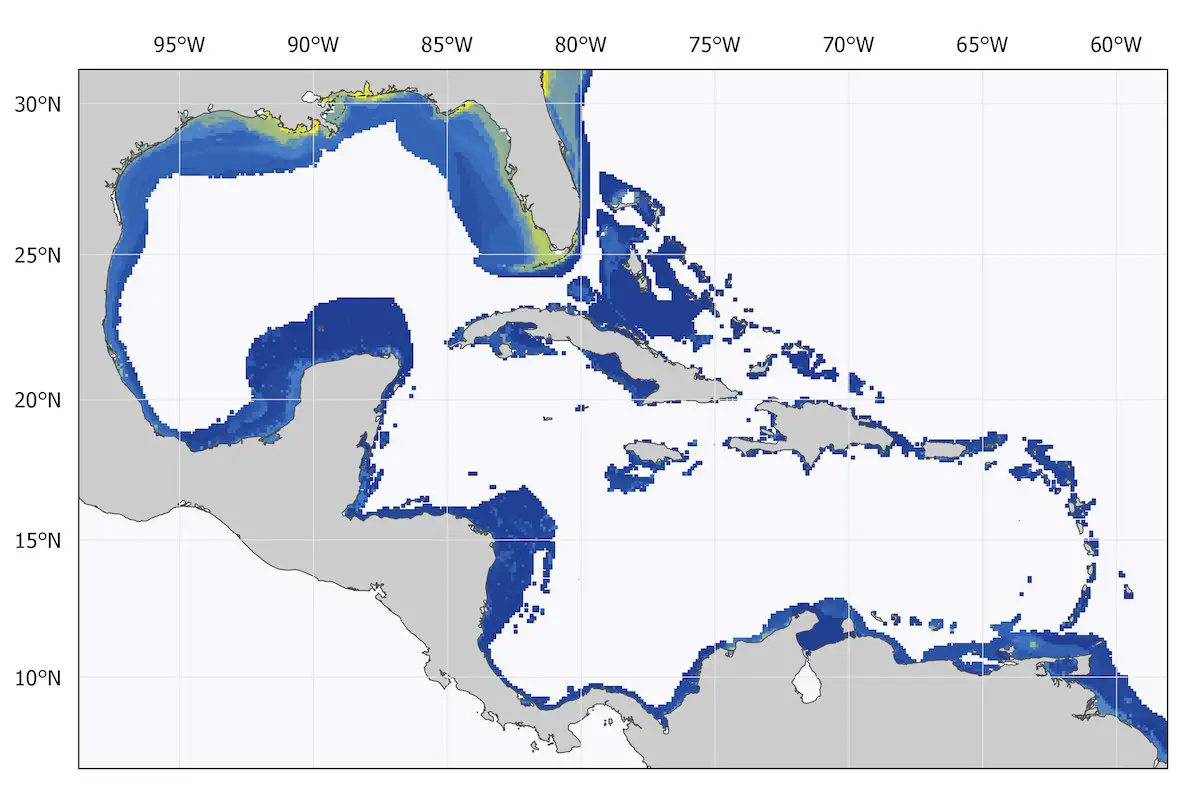
You can fly fish for jack crevalle in many areas along the east coast of the U.S., but the hotspots are Georgia, Florida, Mississippi, Alabama, Louisiana, and Texas. Remember, they prefer warmer water.
Specifically, these fish want water temperatures of 65F to 90F. Anything cooler will send them in search of warmer places.
When the water temperature dips into the low 60’s, jacks will congregate in the warmer canals and tributaries where they can be fished for effectively.
Jack crevalle are pelagic fish that spend the majority of their time patrolling reefs and flats for baitfish and other prey items, but mostly baitfish.
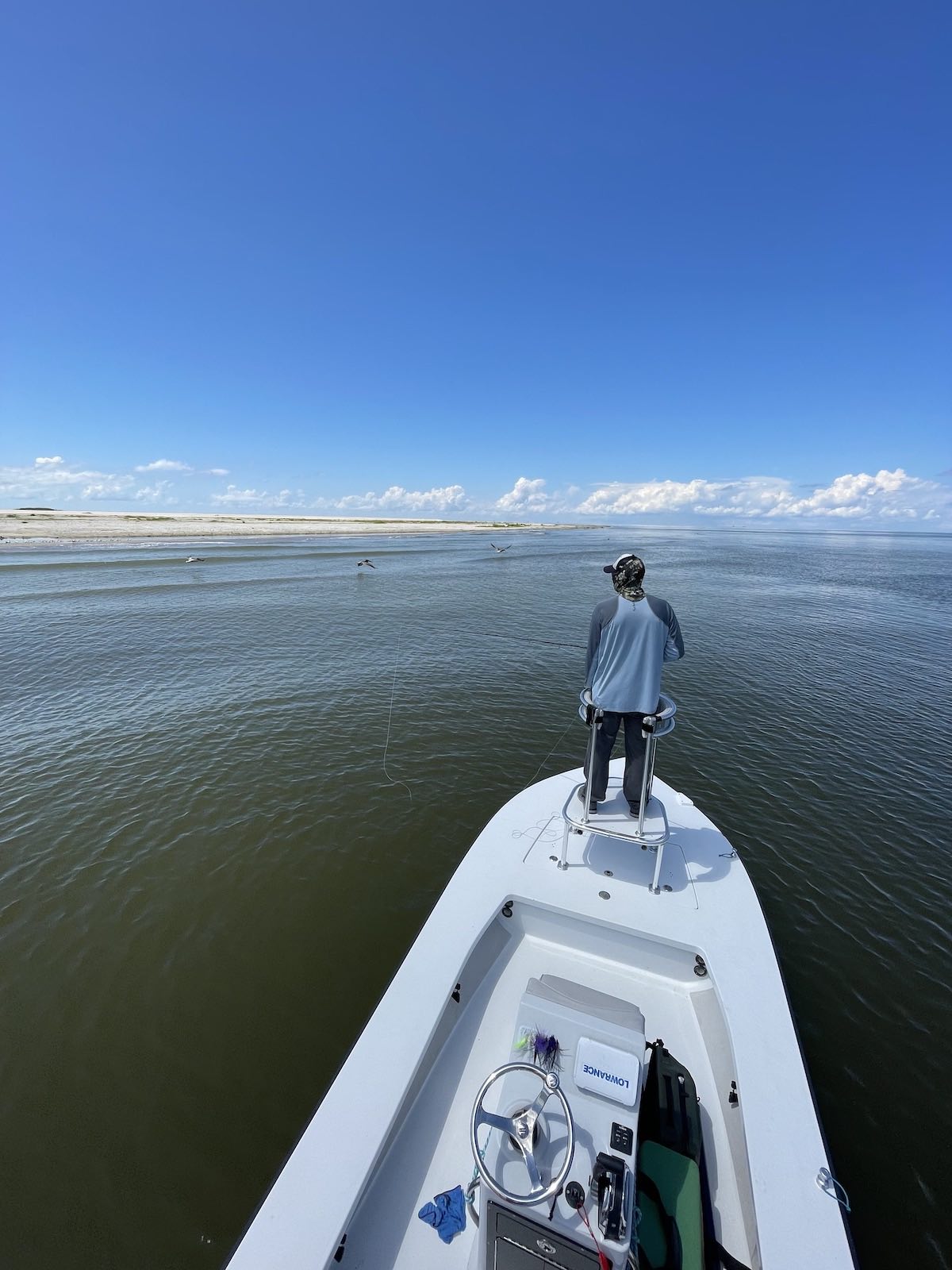
In the above picture I’m scanning the water for fish to cast my fly towards. Just 30 minutes later I noticed two massive jack crevalle casually swimming along the shoreline.
Fly Fishing for Jack Crevalle – Tactics and Strategies
The most effective method to fly fish for jack crevalle is in a boat, preferably a skiff with a casting platform. But, any capable boat can get the job done as long as you can cast in any direction quickly.
If you’re in a boat, watch for feeding schools just offshore. What does a feeding school look like? Honest to God, it looks like bricks are being dropped into the water. Lots of bricks. That’s exactly what it looks like. It’s that violent.
When you see a school of jacks feeding, you’re going to need to act quickly. Try to anticipate the direction the school is moving and get upwind of the fish so that your casts are being made downwind.
When you get relatively close, cut your engine and drift into position so you don’t spook the jacks or baitfish.
Maintain your cool. When you’re surrounded on all sides by frenzied jacks it can be intense.
The first time I found myself in this position I was with a guide in the Gulf of Mexico. He got me into position and all I had to do was cast. But, the fly line at my feet wasn’t cooperating and the school was passing me by.
The guide was a good dude and we got along well, but there was a palpable sense of urgency. Sometimes a guide wants you to catch a fish even more than you do. I could tell he wanted to say, “What are you waiting for?!”
Instead he said, “We gotta cast man.” I said, “I’m trying.”
Once I got the line situated, I made a cast and began stripping a big popper. Fortunately I landed a nice jack crevalle.
It all worked out in the end, but pay attention to where your fly line is and be prepared before it’s time to cast.
Once you cast into a school, start stripping immediately. There’s no need to let your fly sink (if you’re using a streamer).
And don’t stop stripping if the jack misses your fly. Keep stripping. It’s common for them to miss and come back.
I remember once I was stripping a large popper in the midst of a feeding frenzy and a huge jack lunged at my fly and missed it. I kept stripping at the same pace and it came right back and ate. I landed the fish–one of the bigger jacks I’ve ever caught.
If things appear to calm down, keep casting. There are often stragglers looking for a meal.
These marauding schools are often chasing either menhaden or mullet, and pandemonium will ensue.
In the below picture, you can see a menhaden I actually caught on the fly shown, which is unreal.
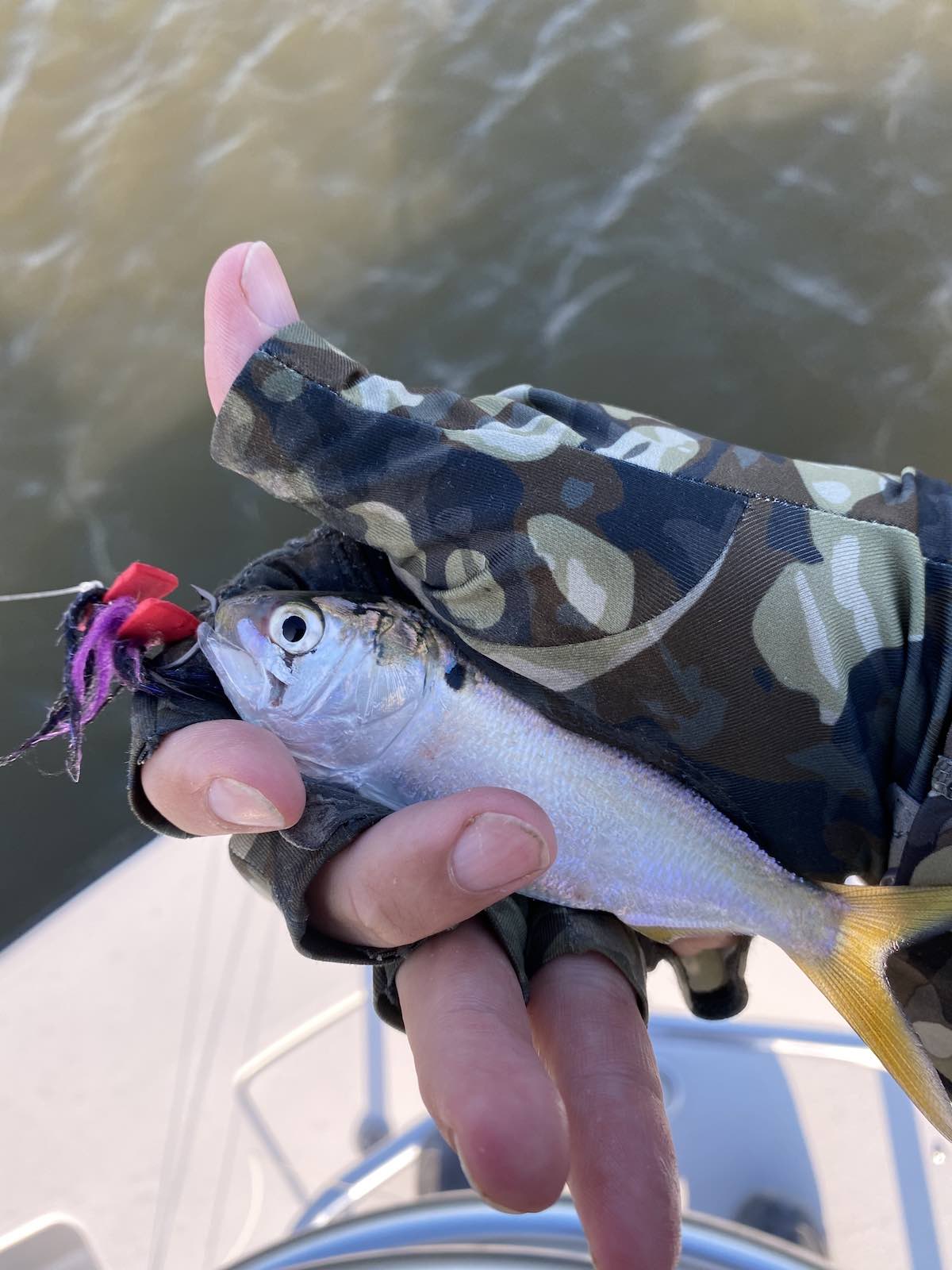
Sometimes jacks focus on giant shrimp instead of baitfish. When this is the case, the jacks are a little less frenzied and they don’t have to move as quickly, but they’ll still gladly eat your fly.
Jacks have very quick digestion systems and therefore must eat often. This helps make them ideal fly fishing quarry.
You want to strip your fly in quickly. Don’t use the ridiculous-looking two-handed method, just strip quickly. The stripping cadense should be a consistent strip-strip-strip. No need to vary the lengths.
Keep your rod pointed at the fly while you strip it in. I’ll mention again, don’t stop stripping if a jack misses your fly. It’ll likely come back, or another one will take it.
In my personal opinion, the most exiting method to fly fish for jacks is using a popper. The take at the surface can be electric.
If you’re casting a popper, strip it in quickly. Try to create a disturbance on the surface and push a lot of water.
When you get a bite, set the hook firmly by using a strip set. Don’t ever use a trout set. (A trout set is when you lift the rod to set the hook.)
If you hook into a jack crevalle, you’re almost certainly going to have to put it on your reel. You generally can’t simply strip these powerful fish in.
When you’re fighting a jack crevalle on a fly rod, avoid hoisting your rod tip up high. Instead, keep it low and use alternating side pressure. This means if the fish is going left, you pull right. And vice-versa. This will tire the fish more quickly.
This is most effectively done by using the butt of your fly rod. Specifically, this means keeping your rod pointed in the general direction of the fish for most of the fight. Make the fish bend the base (butt) of the rod, not the tip.
Big jacks have surprising power and will use their wide flat sides as leverage while they fight.
The biggest jack crevalle I’ve caught thus far was on a popper, and it went on long, deep half moon runs.
When I got the fish to the side of the boat, a shark came up from nowhere and took a bite out of it. We were able to net the fish and get a picture. Needless to say, catch-and-release didn’t happen.
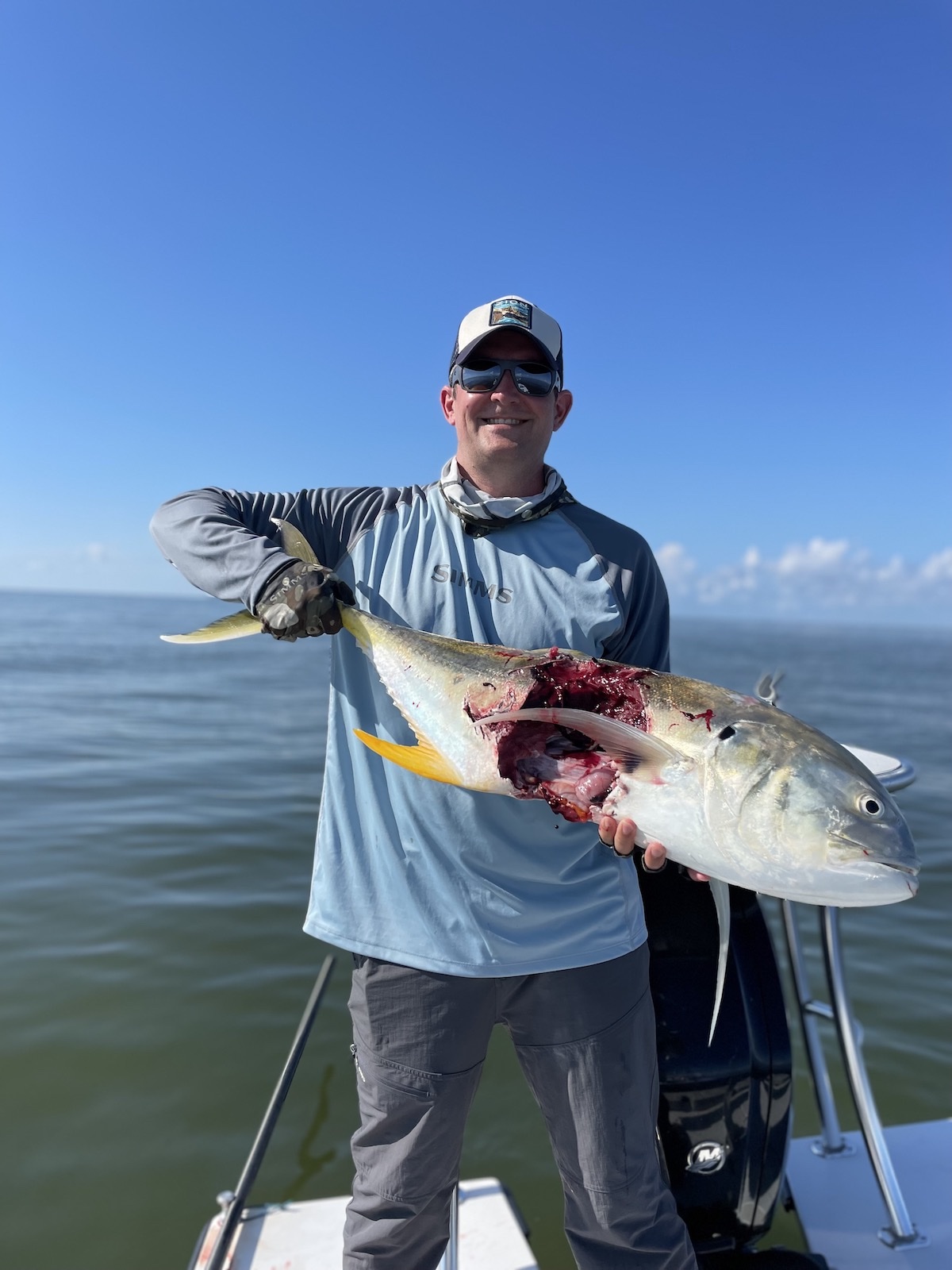
Catching Jacks From The Shore
If you’re fishing from the beach, there can still be plenty of jacks around.
In fact, I’ve seen huge jack crevalle cruising the shoreline just 15-feet off the beach.
If you’re at all serious about catching a jack on a fly, get yourself a stripping basket (this one is my favorite) as it’ll make your life much easier.
My favorite spots are along the shorelines, from a rock jetty or pier, and in narrow channels.
Remember to try casting parallel to the shore too. Sometimes jacks are literally in the surf.
If you’re ever standing in the surf and you see minnows jumping out of the water in synchronization, there’s a decent chance a jack is chasing them. I once caught 13 jacks on 13 consecutive casts off of a jetty in Florida. When you find a school, buckle up.
The biggest mistake fly anglers make when chasing jack crevalle is that they strip their fly in too slowly. Your strips need to be quick. It may even seem too fast, but just do it.
If you ever see a stingray swimming along the shallows, watch for jacks that follow behind it gobbling up food scraps. It’s a relatively common sight.
If you’re into fishing the flats, don’t miss my article on fly fishing for redfish.
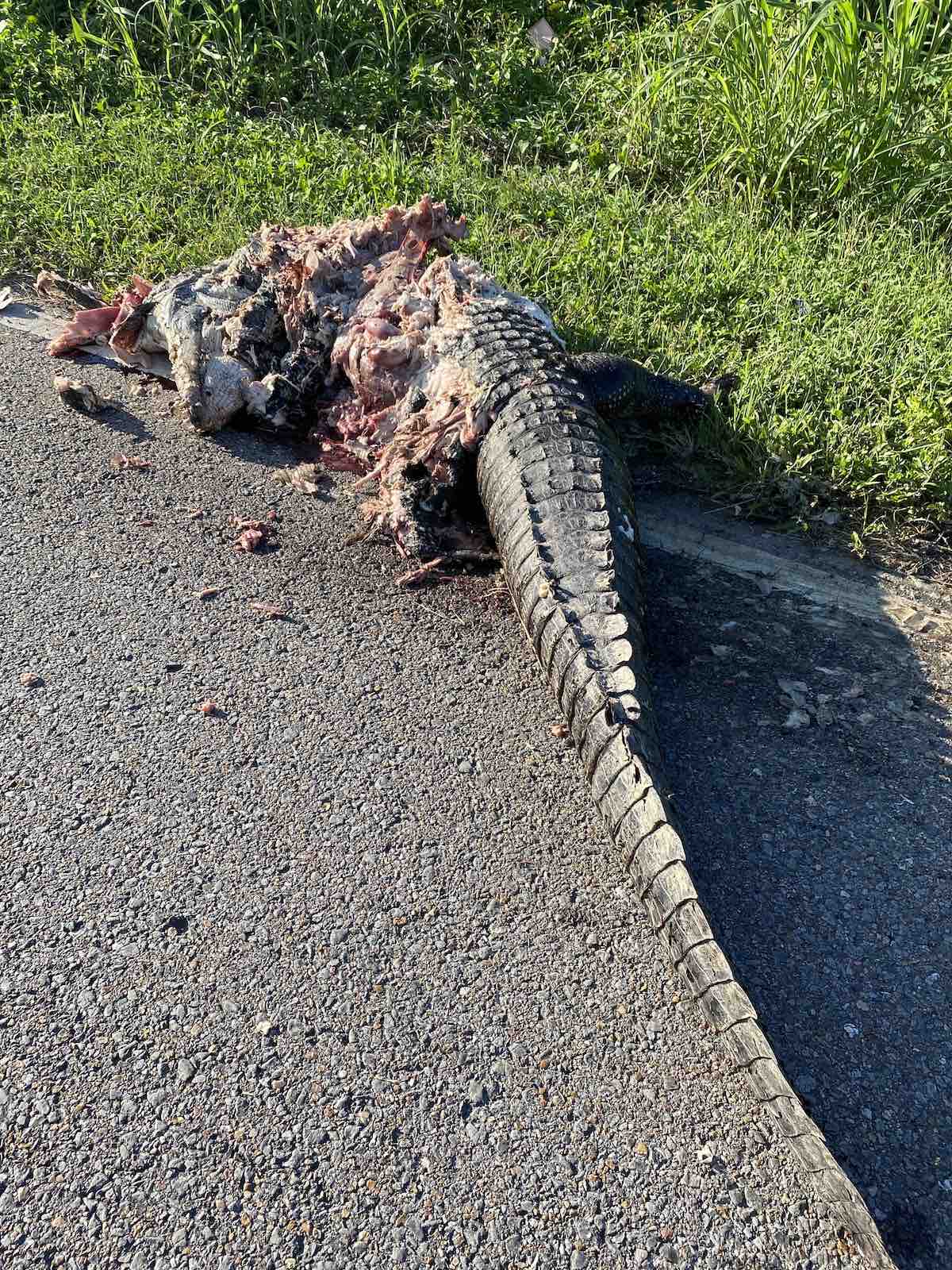
Here’s an interesting roadkill alligator I came across while on a fly fishing trip to Louisiana. Definitely not something you see every day.
The Best Fly Patterns for Jack Crevalle
There’s no need for this section to be lengthy, because jack crevalle aren’t exactly picky eaters.
I’ll show you some of the fly patterns that’ve been productive for me, but with the caveat that anything somewhat similar probably would’ve worked just as well.
While jacks focus on baitfish, they’ll also eat shrimp and crabs. However, shrimp and crab patterns are never my go-to.
Poppers
As I mentioned earlier, poppers are the way to go if you’re onto a school of jacks. Seeing the take is electrifying.
Poppers are most effective when jacks are feeding voraciously, but they aren’t quite as effective if you’re just pounding the water hoping for a hit.
I’d recommend poppers that are 3-6 inches in length, depending upon the size of your quarry. Hook sizes of 2/0, 3/0, and 4/0 are ideal.
Double barrel baitfish poppers work well. There’s a nice selection of poppers that’ll work well for you on this Amazon page.
Streamers
Streamers are my go-to when I’m not sure where the jacks are located. Generally this is when I’m casting from the shoreline or a jetty.
My favorite patterns are the Clouser minnow and Lefty’s deceiver. There’s really no reason you’d need any other streamer patterns.
I’d recommend patterns that are 3-6 inches in length. Again, this depends upon the size of the jack crevalle you’re chasing.
Hook sizes of 1/0, 2/0, 3/0, and 4/0 are ideal for big jacks, and #2 to #6 for medium jacks, but be willing to experiment. Specifically, you can get exactly what you need on this page at Amazon.
Colors
Colors don’t seem to matter much. The biggest jack I’ve ever caught took a green popper that was around 5-inches long.
But, silver, chartreuse, black, purple, and white are all solid choices.
Below is a picture showing some of the poppers and streamers that I’ve found to be effective on jack crevalle. Again, these fish aren’t scrutinizing your fly so these will just give you a general idea of what to cast.
If you’re onto a school, I really believe any one of these would hook fish, and anything that looked remotely similar.
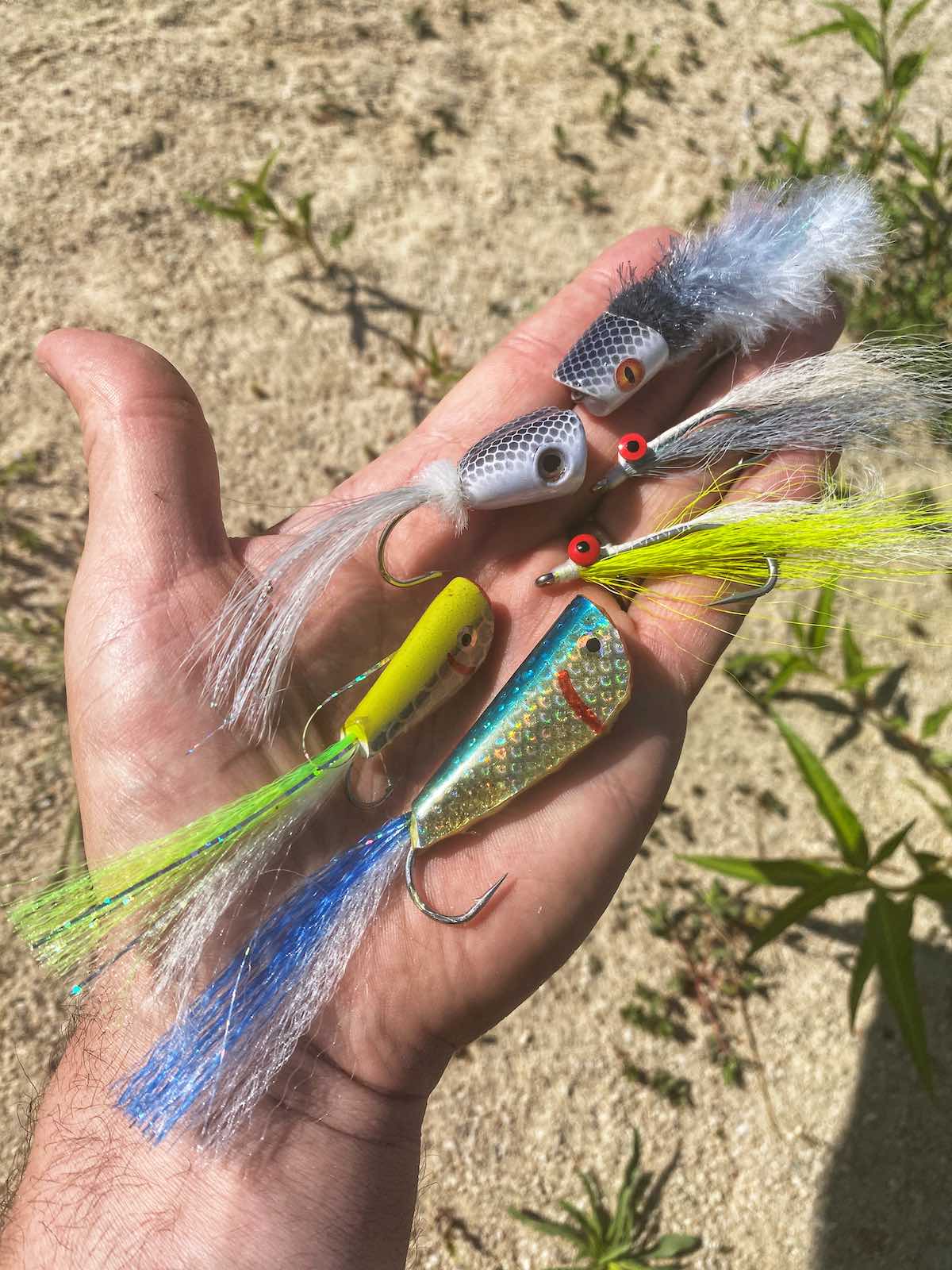
Recommended Fly Gear
Fly Rod
My personal recommendation is to get a quality 9-weight fly rod if you’re chasing jacks. It’s equally applicable to most saltwater gamefish, and is the best overall saltwater fly rod weight in my opinion.
It’s important to remember that while many of the jack crevalle you catch won’t require the muscle of a 9-weight, the wind you face will often require a 9-weight. If you’re new to fly fishing, it’s important to know that a stronger rod makes casting into the wind much more feasible.
Some folks recommend 10-12 weight rods but I think that’s unnecessary. The biggest crevalle jack I’ve caught thus far (pictured above with the shark bite out of it) was landed with a 9-weight without issue. I never felt like I wasn’t in control of the fight.
If you’re traveling to Africa to stalk 50+ pound jacks, by all means grab a 12-weight.
In my opinion, the rod length should be 9-feet.
Fly Reel
I mentioned earlier that jacks will almost always end up on your reel. That is to say, you won’t just strip them in.
Often times a reel is simply a line storage device, for lack of a better term. But that’s not the case with these fish.
Get yourself a quality fly reel with a strong drag system. I personally use Sage quite often, but there are plenty of quality manufacturers including Abel, Hardy, Bauer, Ross, and certain Orvis models.
Fly Line
Match the weight of your fly line to your rod. Put another way, if you use a 9-weight rod, use 9-weight fly line.
I use weight-forward floating line any time I’m fly fishing for jack crevalle, but you could also use a sink-tip line if you want to get deeper.
If you can only get one fly line, get a floating line. Sink-tip line will drown your poppers, but is effective for getting deeper with a streamer.
Leader & Tippet
Since jacks aren’t leader shy at all, I’d recommend going heavier with your leader and tippet. And, there’s no need to overcomplicate things.
Specifically, go with 6-9 feet of 20lb to 30lb fluorocarbon. Fluorocarbon is stronger and less visible than monofilament, but it’s a little more expensive too. Money well spent in my opinion.
Learn how to tie a non-slip mono loop knot. That’s all I use in saltwater.
Stripping Basket
If you’re casting from the surf, you definitely need a stripping basket. If you don’t have one, your line is going to be tangled around your feet after every retrieve–it’s a mess. As I mentioned earlier, this is my favorite model.
General Gear
A good pair of forceps will come in very handy. If you don’t already have a pair, I wrote an article explaining the best fly fishing forceps and how to use them.
This is an important tool because jack crevalle have strong jaws and small but sharp teeth, and removing barbed hooks can take some focus if you’re just using your fingers. Forceps will also allow you to get the fish back into the water more quickly, which is advantageous for the fish.
Can You Eat Jack Crevalle?
When I was growing up our family vacation destination was always an island off of the Gulf coast of Florida. My dad and I would fish much of the time from the beach, and often caught jack crevalle, redfish, ladyfish, sheepshead, the occasional snook, and a few juvenile sharks.
I’ve never been a big fan of eating fish, I’ve just never liked the taste much. But, my dad often took a few fish back to the villa to fillet and cook for dinner.
What I can tell you is that jack crevalle is a very dark meat, and it’s a bit oily too. The fishy taste was never a favorite around our dinner table.
If you do decide to eat one, make sure you slice its gills on both sides soon after catching it so that it bleeds out. The meat will turn a lighter color while cooking.
It’s worth mentioning that jacks can harbor a toxin called ciguatera, which is more commonly found in reef fish. I’d steer clear of eating jacks, unless you’re starving on a deserted island.
Summary
Fly fishing for jack crevalle isn’t something most angler focus on, and honestly I’m just fine with that. I think it’s great that so few people target them. More for me.
They aren’t easily spooked, they don’t require a delicate presentation, and they’re indiscriminate eaters, but their power and fury make up for it. They’re like our own version of a Giant Trevally, right here in the good ‘ol U.S.A.
These fish are special to me, I have a history with them, and they’re perhaps my favorite gamefish.
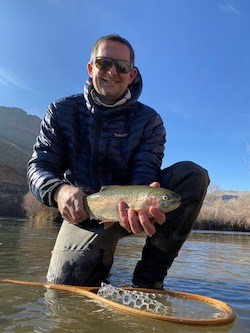
About the Author
My name's Sam and I'm a fly fishing enthusiast just like you. I get out onto the water 80+ times each year, whether it's blazing hot or snow is falling. I enjoy chasing everything from brown trout to snook, and exploring new waters is something I savor. My goal is to discover something new each time I hit the water. Along those lines, I record everything I learn in my fly fishing journal so I can share it with you.
Follow me on Instagram , YouTube, and Facebook to see pictures and videos of my catches and other fishing adventures!
